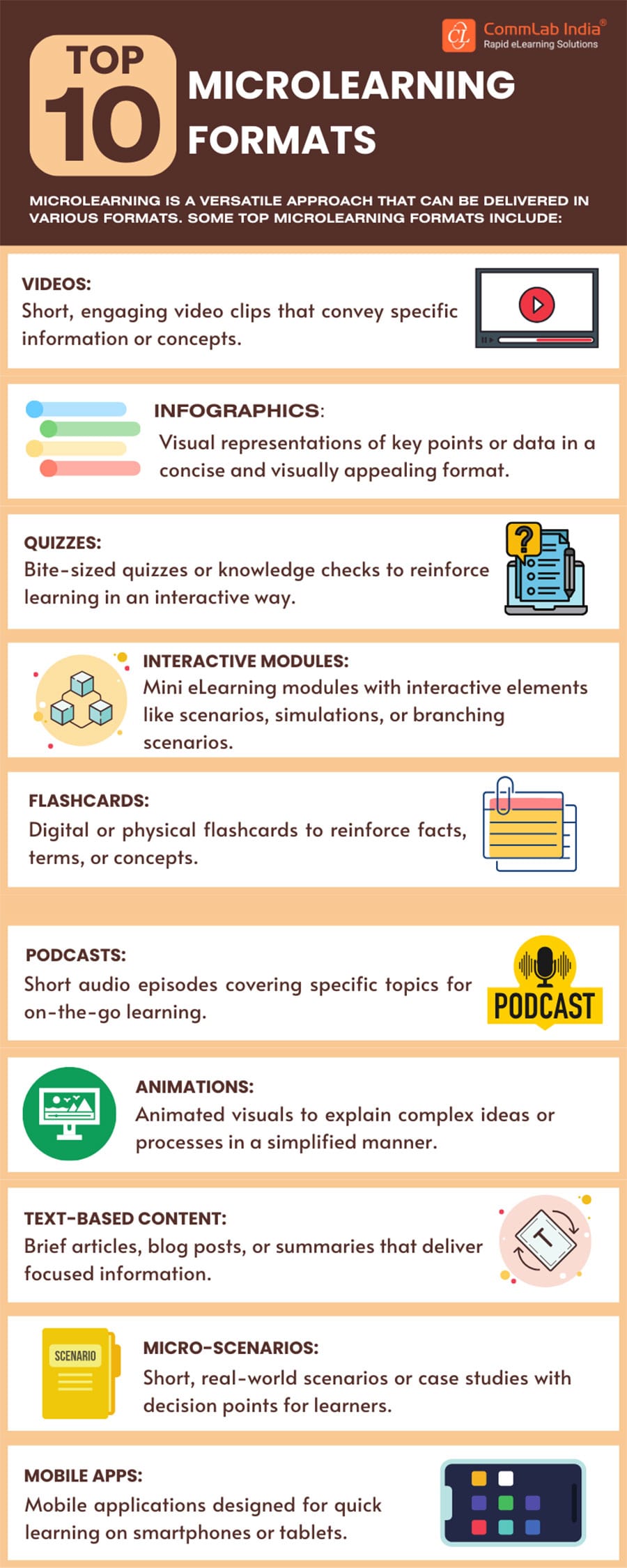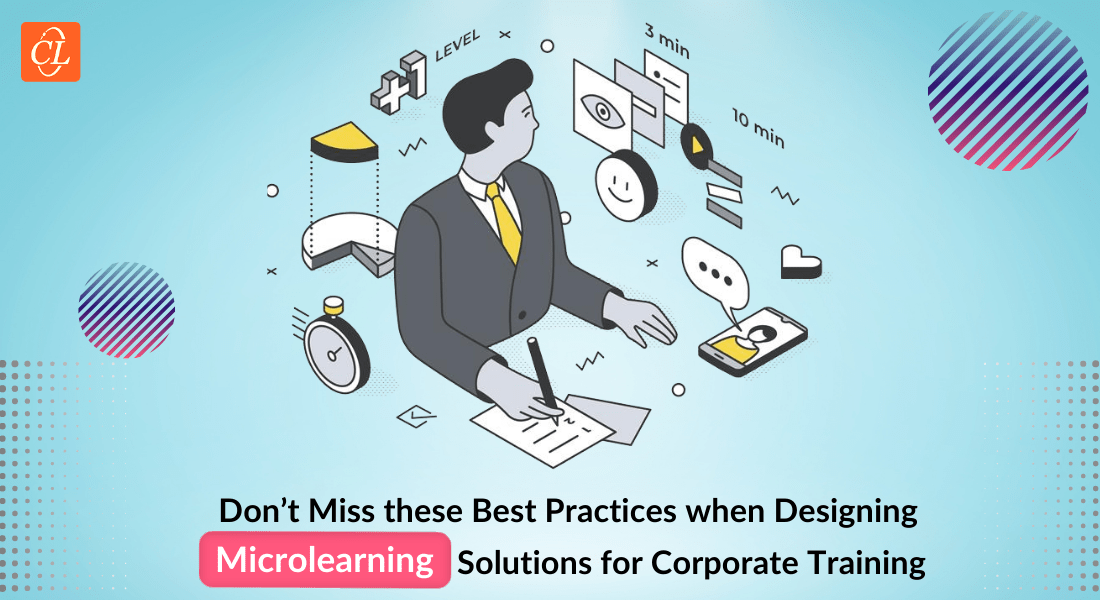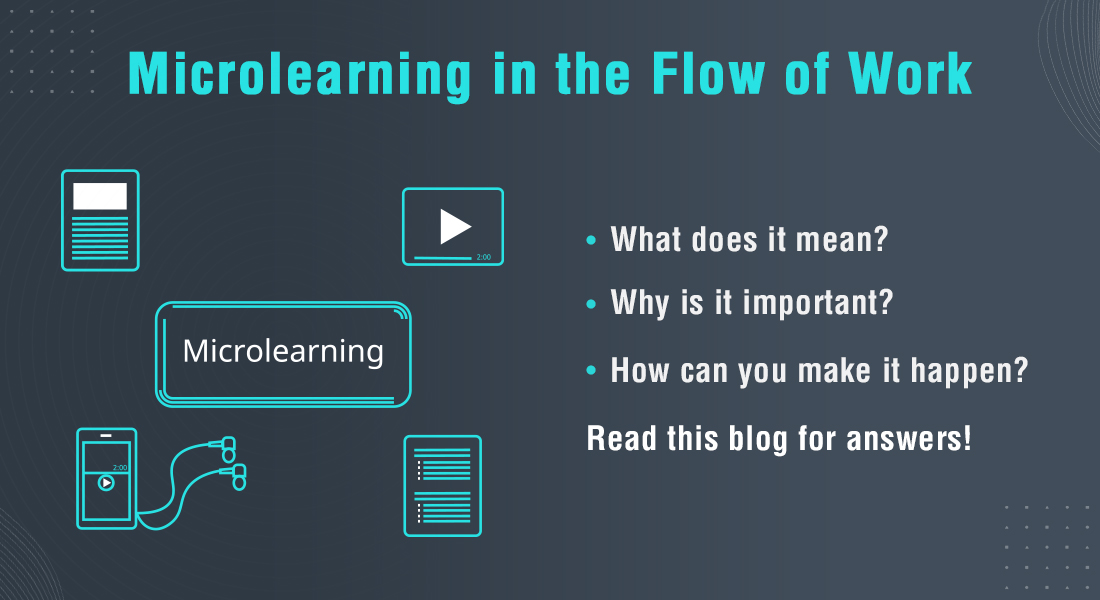Why Microlearning is a Top Corporate Training Trend for 2025

Microlearning is set to dominate corporate training in 2025, and for good reason. It’s not a new idea, but L&D teams are giving it a fresh spotlight. Forget long, drawn-out courses—it delivers quick, bite-sized modules that are easy to digest and actually stick. It’s perfect for when employees need fast, actionable tips, not an info overload. As companies hunt for smarter ways to upskill their teams, it is stealing the show. Game-changer? Absolutely!
Ready to dive deeper? Let’s explore more in the blog!
→ Download eBook: Corporate L&D Trends 2025 – Get the View from the Trenches
Table of Content
- What is Microlearning?
- What are the Benefits of Microlearning for Organizations?
- How to Leverage Microlearning for Corporate Training?
- What are some Valuable Tips to Craft Effective Microlearning?
- What are the Popular Microlearning Formats?
- How to Measure the Impact of Microlearning and Strive for Continuous Improvement?
- Where to Use Microlearning Formats in Corporate Training?
- What are the Best Practices for Creating Impressive Microlearning?
What is Microlearning?
Microlearning is a learner-centric strategy that breaks down complex information into smaller, easily digestible modules. These bite-sized nuggets of information usually range between 3-15 minutes. The standout feature is that it addresses a single learning objective and provides just-in-time learning. A microlearning lesson can be used as a standalone training material or as part of a training series.
This approach helps organizations meet the needs of modern learners who often prefer short, focused bursts of information over lengthy, time-consuming sessions. Apart from that, accessing microlearning lessons is convenient and learners can fit them in their busy schedules.
Now that microlearning definition is clear, let’s explore more about it!
What are the Benefits of Microlearning for Organizations?
Microlearning Helps Organizations Take Their Corporate Training to a Whole New Level
Some of the benefits include:
- Increased learner engagement
- Promotes knowledge retention
- Helps train larger groups of employees effectively
- Assists to improve overall employee training experience
Increased Engagement and Retention
When it comes to learning, engagement and retention are key. This is where microlearning solutions can help. As the training material is delivered in small doses, it keeps learners engaged and focused. And because microlearning modules are self-contained, learners can complete them at their own pace and on their own time. This adds to convenient learning with less disruptive to workflows. All these further aids to boost retention rates.
Flexible Learning
Microlearning allows employees to learn on their own schedule and at their own pace. It makes it more flexible way of learning. This type of learning is especially beneficial for busy employees who may not have time to attend traditional classroom-based training sessions. Additionally, employees can also revisit specific topics whenever needed. This makes it ideal for employee training and employee development.
Time Saving
An ATD analysis reveals that creating microlearning content requires an average of 18 hours, significantly less than the 67 hours typically needed to develop a classroom-based course.
Microlearning content is delivered as small chunks. Plus, there are several microlearning platforms and eLearning authoring tools available to create content. This can help save a lot of time in development. At the same time, the content too is very easy to access and digest, so learners can easily fit learning into their busy schedules. Thus, its time saving for the employees too.
Improved Learning Outcomes
Microlearning methods are designed to be more engaging and effective as compared to traditional learning methods. As a result, the employees can retain information and apply it to their work. Additionally, the ability to customize content to each individual’s learning needs, further increasing the effectiveness of the approach.
Different Learning Styles
Learners absorb and retain information differently, so offering microlearning modules that cater to different learning styles can improve the understanding and application of concepts for all types of learners.
How to Leverage Microlearning for Corporate Training: Task Analysis
Task analysis is like the roadmap for creating microlearning solutions. It helps break down job requirements, and risk factors making the corporate training more focused, practical, and effective. As a part of the task analysis, it is important for you to understand the need/opportunity for microlearning.
As a Learning and Development (L&D) professional, you will have to identify the specific needs and opportunities within the organization. Engaging stakeholders is essential to gather insights that will shape the entire training process.
1. Learning Objectives
Start by understanding your organization’s learning objectives. What skills or knowledge do you wish to impart through microlearning? Understanding the end goals helps in tailoring the content to meet these objectives efficiently. Therefore, you should put a lot of emphasis on this step.
2. Intended Frequency
Determine the intended frequency of the microlearning modules. Do you want your employees to consume them daily, weekly, or monthly? This information is vital for creating content that aligns with the organization's training schedule.
3. Difficulty of Learning
Explore the difficulty level associated with the learning content. Are the topics complex, requiring in-depth understanding, or are they more straightforward? Based on this knowledge, you will be able to design employee learning content that matches the cognitive abilities of the target learners.
4. Risk Factors of Failing to Learn
Along with the information required for the design, it is also very important to inquire about the potential risk factors associated with failing to learn the specified skills or information. The risk factors may be slump in sales or improper use of equipment. Understanding the consequences of inadequate training enables you to be very mindful in developing content that addresses these risks, promoting a proactive learning approach.

Corporate L&D Trends 2025
Get the View from the Trenches
- Win with AI
- Design for the agile workforce
- Unlock scale, volume, quality
- Make an impact
- Much more
What are some Valuable Tips to Craft Effective Microlearning?
1. Bite-sized Modules
The essence of microlearning lies in its bite-sized nature. Break down complex topics into short, focused modules that can be easily consumed. This ensures that learners can absorb information without feeling overwhelmed.
2. Interactive Elements
Incorporate interactive elements to enhance engagement. Whether it's quizzes, polls, or simulations, interactive components make the learning experience more dynamic and memorable.
Here’s a video that will help you know more about the effectiveness of interactive learning:
3. Real-life Scenarios
Integrate real-life scenarios to contextualize the information. Relatable examples help learners connect theory to practical applications, increasing retention and practical application of knowledge.
4. Personalized Learning Paths
Recognize that not all learners are the same. Offer personalized learning paths that cater to individual preferences and pace. This fosters a sense of autonomy and ensures that each employee can progress at their own speed.
5. Multimedia Integration
Leverage multimedia elements to cater to different learning styles. Combining text with visuals, audio, and video creates a multi-sensory experience that caters to diverse learners.
What are the Popular Microlearning Formats?
Now, your next course of action would be to measure the impact of the microlearning modules developed. Measuring and continuous improvement help ensure the sustained success.
How to Measure the Impact of Microlearning and Strive for Continuous Improvement?
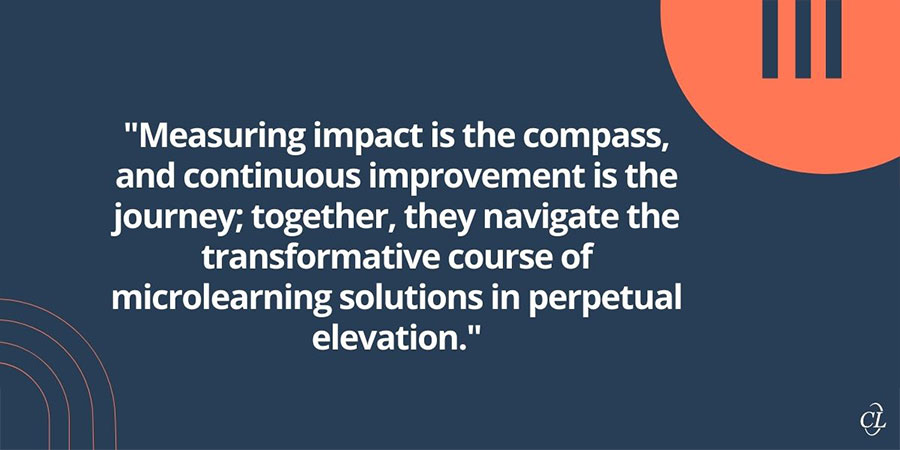
1. Analytics and Feedback
Utilize learning analytics tools to track learner progress and engagement. Additionally, gather feedback from users to understand their experience and identify areas for improvement.
2. Iterative Design
Embrace an iterative design approach. Based on analytics and feedback, continuously refine and update the content. This ensures that the corporate training courses remains relevant and effective over time.
3. Assessing Learning Outcomes
Regularly assess learning outcomes against the predefined objectives. This allows for a data-driven approach to measure the impact of microlearning on employee performance and skill development.

Corporate L&D Trends 2025
Get the View from the Trenches
- Win with AI
- Design for the agile workforce
- Unlock scale, volume, quality
- Make an impact
- Much more
Where to Use Microlearning Formats in Corporate Training?
Employee Onboarding
Microlearning is a perfect way to welcome new employees and get them familiarized to the company! You can leverage different formats, such as microlearning videos, infographics and animations to introduce new hires to the company's culture, policies, and procedures. This will allow you to ensure a smoother onboarding process and helps employees grasp the essential information quickly.
Sales Training
Knowing and remembering all the product features, updates can be quite difficult. But microlearning makes it easy for your sales team. You can use a variety of microlearning formats to provide information on specific product features, benefits, latest updates, usage, etc. Moreover, you can also equip your sales representatives with selling techniques, useful tips, best practices, and more. It supports targeted learning and enables sales representatives to absorb information efficiently and apply it in customer interactions.
Compliance Training
To avoid your organizations from any legal complications, providing your employees with compliance training is a must. And you can keep your workforce up-to-date on compliance regulations through the use of various microlearning formats. You can make use of videos, infographics, interactive eBooks, podcasts, quizzes, micro-scenarios, etc. These formats will helps you ensure that your employees remain well-informed about legal requirements.
Performance Support
You can leverage different formats to provide your employees just-in-time support. This can include troubleshooting guides, quick-reference materials, short videos addressing common challenges, etc. This way it enables just-in-time learning, thereby boosting their productivity and overall performance.
Looking to boost performance and engagement? Discover 5 powerful microlearning formats that can transform the way your team learns and grows!
What are the Best Practices for Creating Impressive Microlearning?
1. Define Your Microlearning Goals
In microlearning design it’s crucial to start with a clear understanding of your learning objectives. Begin by asking yourself what specific skills or knowledge you want learners to acquire. Are you concentrating on onboarding new employees, enhancing product knowledge, or reinforcing specific procedures?
Utilizing the SMART objectives can significantly enhance your goal-setting process. This involves defining learning objectives that are Specific, Measurable, Achievable, Relevant, and Time-bound (SMART). For instance, instead of a vague aim like “improve employee knowledge,” set a specific goal such as “increase product knowledge by 30% within three months of onboarding.”
2. Embrace the Power of Storytelling
Storytelling isn't just for children's books. It's a powerful tool to engage learners, make information relatable, and enhance knowledge retention.
Check out this video to unlock powerful reasons why you should embrace storytelling when designing learning—it's an opportunity you won’t want to miss!
Here's how to weave exceptional stories in learning:
- Develop relatable characters: Strong stories start with relatable characters. Think about your learners and their challenges. Create characters they connect with—like a new hire struggling with a software system or a seasoned salesperson dealing with a tough customer.
- Craft a compelling narrative: A list of facts won’t engage learners. Build a narrative with conflict, obstacles, and resolutions to keep them hooked. Use dialogue, actions, and vivid descriptions to bring the story to life. Show, don’t tell—let learners visualize the scenario, making the lessons more impactful.
- Embed learning in the story: Seamlessly integrate key concepts and skills into the narrative. Instead of dumping information, let the story reveal skills as characters face challenges. This keeps learners engaged and helps them better understand how to apply what they’ve learned in real situations.
3. Keep it Concise and Focused
"Micro" is key. Limit each module to 5-10 minutes, focusing on one specific topic. This helps learners grasp essential concepts without feeling overwhelmed.
Prioritize the most critical information learners need and avoid unnecessary details that might distract them. Instead, provide clear explanations with practical examples that illustrate the topic effectively.
Use simple, direct language and avoid jargon or technical terms unfamiliar to learners. By following these guidelines, you’ll create engaging microlearning experiences that improve retention and application.
4. Make it Visually Appealing
Humans are visual creatures, processing information faster and retaining it better when presented visually. Here's how to leverage visuals in your microlearning:
- Use high-quality visuals: Employ images, infographics, animations, and video-based learning modules that are clear, professional, and relevant to the content. Avoid blurry or pixelated visuals that detract from the learning experience.
- Align visuals with content: Ensure visuals directly support and enhance the information presented. Don't use visuals for decoration; they should have a clear purpose and contribute to understanding.
- Choose the right visual format: Select the most appropriate visual format based on the content. Infographics are great for summarizing complex processes, while animations can explain step-by-step procedures effectively.
5. Add Fun with Gamification
Include time-limited challenges or tasks to keep excitement high and offer rewards like certificates or recognition. These incentives promote completion and encourage learners to revisit content for practice.
Gamification makes microlearning fun, engaging, and effective. Interactive features like “click to continue” and drag-and-drop turn tasks into enjoyable activities requiring active participation. Rewards, missions, and leaderboards combat disengagement and foster healthy competition. With AI-powered gamification, the experience becomes more personalized, as AI suggests tailored challenges and rewards based on individual progress. This keeps learning effective and enjoyable while enhancing outcomes.
6. Incorporate Interactive Elements
When designing microlearning, it’s essential to go beyond merely presenting information; actively engaging learners is crucial for effective retention and application of knowledge. Here are some best practices for incorporating interactive elements:
- Quizzes and Polls: Utilize interactive quizzes and polls to assess learners' knowledge and gauge their understanding of the material. Providing immediate feedback and detailed explanations not only reinforces learning but also helps learners identify areas that need improvement. This instant interaction keeps learners motivated and engaged.
Want to create effective quizzes? Discover why QuizBot is a must-try tool.
- Simulations and Role-Plays: Develop realistic scenarios that allow learners to practice their skills in a safe and controlled environment. Simulations can mimic real-life situations, offering learners a chance to apply their knowledge practically. Role-plays can help in developing critical thinking and decision-making skills, making the learning experience more immersive.
- Drag-and-Drop Activities and Games: Incorporate fun and engaging activities that require learners to apply their knowledge in a hands-on manner. Drag-and-drop tasks encourage active participation and can enhance understanding through playful learning.
7. Leverage Mobile-First Design
With the rise of mobile learning, ensure your microlearning modules are designed for responsiveness and optimized for smartphones and tablets for just-in-time learning. Here are some best practices for effective microlearning design:
- Design responsive modules for seamless viewing on all devices.
- Allow learners to download content for offline access.
- Use diverse formats like text, videos, and quizzes to suit different learning styles.
- Optimize images and videos for fast loading times.
- Break content into bite-sized, easily digestible units.
- Create clear, intuitive navigation for effortless module access.
Here’s a short video to understand more about mobile learning.
8. Utilize eLearning Authoring Tools
When designing microlearning, employing eLearning authoring tools is a best practice that can greatly enhance the development process. These tools come equipped with pre-built microlearning templates allowing instructional designers to quickly create visually appealing and engaging content without starting from scratch.
Additionally, the multimedia capabilities of these tools enable the seamless integration of videos, audio clips, and animations, enriching the learning experience and catering to different learning styles.
One of the primary advantages of using eLearning authoring tools is the significant reduction in development time and cost. By streamlining the creation process, teams can produce high-quality microlearning modules more quickly, allowing for faster deployment and feedback cycles.
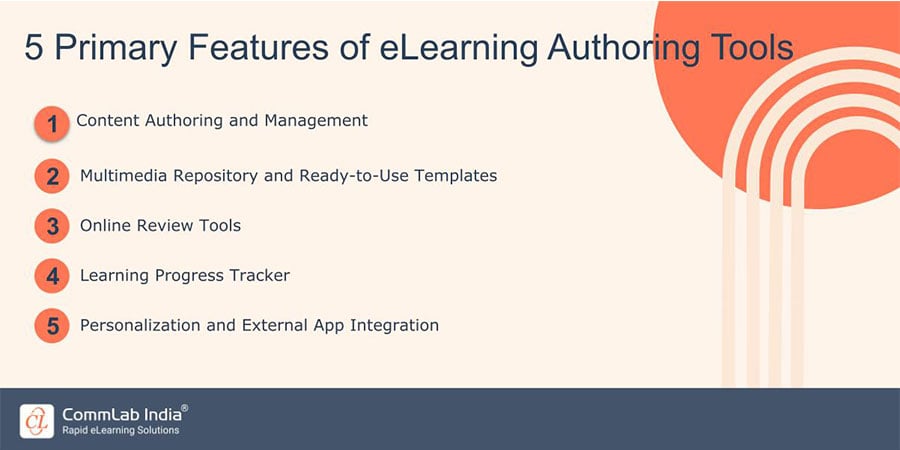
9. Test, Iterate, and Improve
Launching a program is just the beginning—continuous improvement is key to maximizing the impact of microlearning solutions. Start by gathering feedback through surveys and A/B testing to understand learner engagement and comprehension. Use this data to identify and refine areas needing improvement, such as confusing concepts or more effective formats. Regularly update content by simplifying complex ideas, adding interactive elements, and keeping information current to ensure relevance.
Agility is essential as the corporate landscape evolves, requiring frequent updates to reflect new trends and policies. Encourage open communication to gather ongoing feedback, making learners feel valued and ensuring their input shapes the corporate training experience. This approach enhances learning while equipping employees with up-to-date skills and knowledge.
10. Promote and Track Your Microlearning Modules
Don't let your training modules go unnoticed. Actively promote them through emails, Learning Management Systems (LMSs), and social media to reach more learners. Emails allow for personalized communication, while social media fosters community and discussion. Highlighting the value of these modules helps capture attention and motivates learners to participate.
Tracking engagement and completion rates is vital to measure the effectiveness of your microlearning strategy. Analyze metrics like completion rates, time spent on modules, and learner feedback to identify areas for improvement.
Bonus Tip: Embrace Microlearning Ecosystems
Integrating microlearning modules into a broader learning ecosystem can significantly enhance the learning experience. By creating comprehensive learning paths, you can guide learners through a structured journey that builds on their knowledge incrementally.
In addition to structured learning paths, incorporating opportunities for reinforcement and practice is crucial. This can include spaced repetition of key concepts, quizzes, and hands-on activities that allow learners to apply what they’ve learned in real-world scenarios. By creating a dynamic environment where microlearning is supported by other resources and activities, you not only promote deeper understanding but also encourage continuous learning and skill development.
Start Shaping the Future of L&D Today!
Microlearning isn’t just a trend—it’s revolutionizing corporate training programs and shaping the future of how employees learn and grow. By delivering bite-sized, focused content, microlearning makes corporate training faster, more effective, and better suited to the needs of today’s busy workforce.
Want to explore more trends like and embrace the future of corporate learning? Our exclusive Corporate L&D Trends 2025 eBook dives deep into the game-changing trends that are set to redefine corporate training over the next few years. This eBook will provide invaluable insights to help you future-proof your learning and development strategies.
Download it now and transform the way your team learns, grows, and achieves success!



